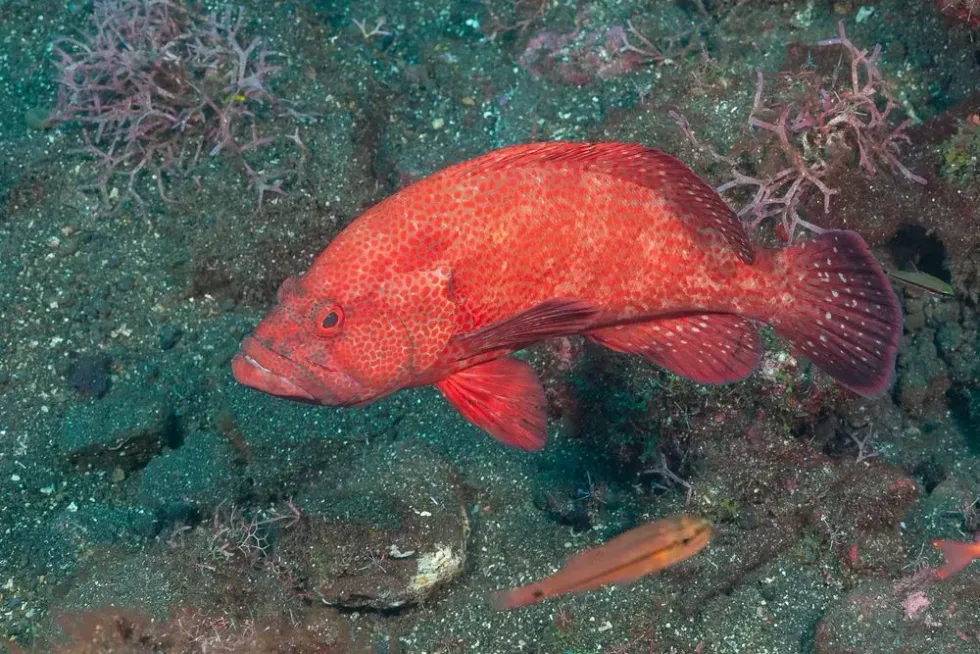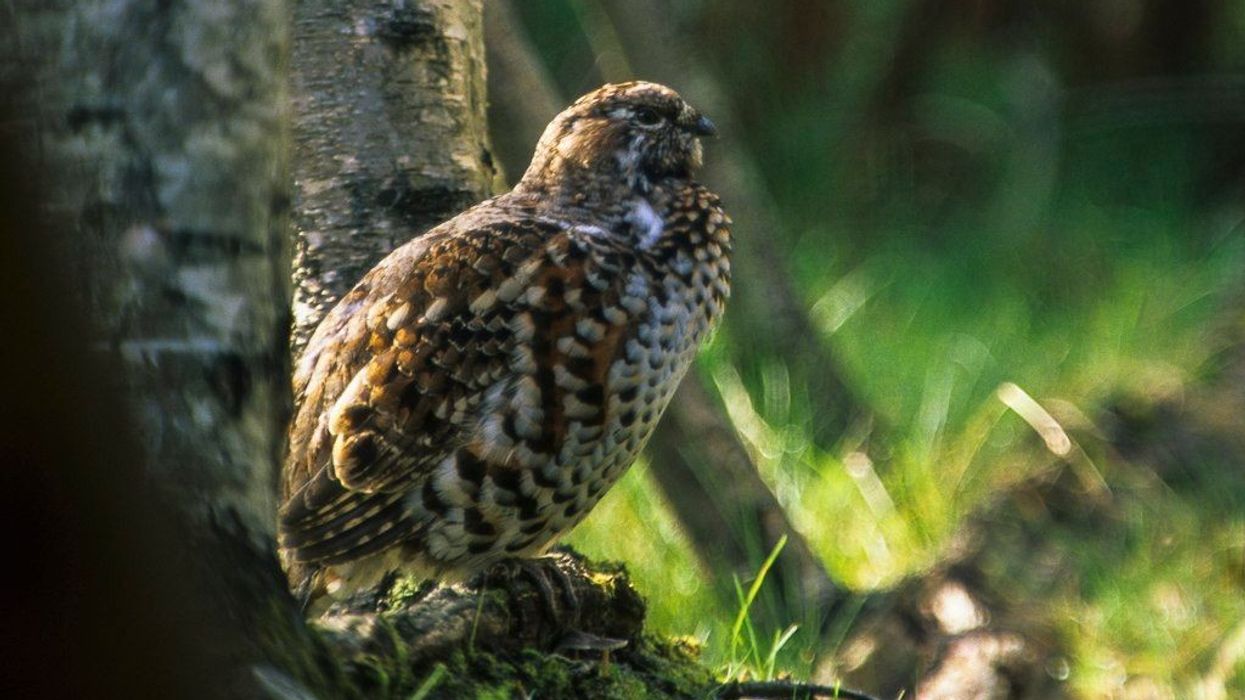Do you like strawberries? Even if you do not, you are bound to love the Grouper, Strawberry.
The Strawberry Grouper (Cephalopholis spiloparaea) is a fish found exclusively in the Pacific and nearby sea and belongs to the family Serranidae, and a dangerous carnivore indeed! These orange-red fish have sharp teeth in their mouth, which look like thick pins, so if you ever see one, be sure to admire from afar only!
This fish will usually stay in the depth of the Pacific Ocean, and weighs a whopping 5-6 lb. Talk about being heavy!
They also enjoy sunbathing close to the surface during day time but will travel to the depths of the ocean to hunt for prey at night. Their hunting strategy is sucking in prey, and then biting down on them.
It is a technique that keeps them well-fed, and able to breed well.
However, the Speckled Hind fish does not breed very often annually, which means their population is declining even if they do not have an active predator or are being hunted by humans. Humans rarely go after this fish since it can not be eaten, and has no major economic use other than regulating populations of other, smaller fish.
If you enjoy reading about fish, then do make sure you have a look at the giant grouper and black marlin as well and do not forget to share with your friends!
Strawberry Grouper Interesting Facts
What type of animal is a strawberry grouper?
This Grouper fish (Cephalopholis spiloparaea) is a type of fish.
What class of animal does a strawberry grouper belong to?
The Strawberry Grouper (Cephalopholis spiloparaea) belong to the class of fish.
How many strawberry groupers are there in the world?
The 159 species of Grouper Fish found around the world are extremely valuable ecologically, and many of them are economically important wherever they are found.
Where does a strawberry grouper live?
Strawberry Grouper fish live in the ocean. The grouper is mainly found in shallow tropical waters between coral and man-made reefs.
What is a strawberry grouper's habitat?
Offshore, the Strawberry Grouper can be found below 40 m on Indo Pacific coral reef, subtidal marine beds, coastal seas, and open waters. These Hind fish prefer rocky substrates that are 200-390 ft in depth. Young Hind prefer shallower waters to swim in.
Who do strawberry groupers live with?
Strawberry Grouper are carnivores fish that live solitary lives. They do not enjoy interacting with other related fish in the depths of the reef, and scientists have often said that this orange fish is often in its own world paying little mind to others.
How long does a strawberry grouper live?
Grouper Fish live to be at least 37 years old, making them a relatively long-lived species. The only other species to rival this life span is the Goliath Grouper, which is the biggest Grouper fish in the world, with a length of 2.5 ft on average.
How do they reproduce?
Low numbers of Atlantic Grouper Fish can be found in any one location for the majority of the year. Broadcast spawning is a method used by groupers to replicate at these locations, in which many females and many males simultaneously release eggs as well as sperm into the large water body in on and around the reefs.
The spawning season of Calico Grouper is from the month of April to September in the Gulf of Mexico.
What is their conservation status?
The conservation status of this Spiloparaea fish is Least Concern. However, this status may change soon, since they are not reproducing at rates fast enough to keep up with their predation by bigger fish as well as unintentional capture in human nets.
Strawberry Grouper Fun Facts
What do strawberry groupers look like?
Strawberry groupers have a standard grouper shape and, like many other groupers, can change their coloration depending on their mood. Its usual coloration is pink with light pink blotches all over the body. There are small greenish-blue spots on the face and light pink spots below the mouth.
How cute are they?
They are not the cutest fish in the sea. They may have a lovely orange-red color that enamors the people they come across, but other than that, there is not much in these fish that might attract anyone.
How do they communicate?
These orange fish communicate much like any other fish around, by moving their fins, using their body, and the unique chemicals they leave behind in order to mark their territory.
How big is a strawberry grouper?
A Strawberry grouper is a very big fish! Not only is it significant in pound weightage, but it is also considerable in length. It is about 12 in long as an adult, which makes the Orange Hind around the same length as a juvenile Surgeonfish.
How fast can a strawberry grouper swim?
Since it is a very large fish, and very heavy in terms of pounds, it is a slow swimmer.
How much does a strawberry grouper weigh?
The weight of Strawberry Grouper is approximately 4-6 lb.
What are their male and female names of the species?
Male and female species have the same name, which is simply known as Strawberry Grouper Fish. They as a species, however, have several names like the strawberry hind, strawberry rock cod, orange rock cod, and the strawberry cod. Talk about having multiple names!
What would you call a baby strawberry grouper?
There is not any specific name for baby Strawberry Grouper.
What do they eat?
Tiny fish, invertebrates including crabs and shrimp, and cephalopods make up the Strawberry Grouper's diet. Since this fish swallows its food whole, it will consume just as much as it can.
The Strawberry Grouper Fish is attracted to food. When these marine fish open their overly large mouths, they create a strong suction and are swallowed whole. These Grouper fish are aggressive feeders by nature.
Are they dangerous?
This strawberry Hind Grouper fish is not dangerous for humans. However, with their voracious appetites, they can be dangerous to the various smaller fish that dwell in the Pacific.
Would they make a good pet?
Strawberry Groupers are huge, aggressive saltwater fish that thrive in aquariums with a lot of space. In captivity, most groupers can reach a length of over 12 in and will need a wide tank with plenty of swimming space and hiding spots to thrive.
Strawberry Groupers can be housed in reef ponds, but if given the opportunity, they will consume smaller fish and shrimp.
So it is not so easy to keep these Strawberry hind fish as a pet. Also, it is not recommended that you keep more than three Red grouper at a time.
Did you know...
The EDF has issued a consumption warning due to the high mercury levels in these massive fish. These Calico Grouper fish live to be 40 years old, but they only reproduce once every few years, rendering them vulnerable to overfishing.
If you ever want to eat a Grouper (Strawberry), then do not! This orange fish can be poisonous.
Some species of grouper are very expensive due to their lack of availability and their role in the culinary industry. For this, the snappers are considered better than the groupers as it is said that their meat tastes better.
In fact, even Yellowedge Groupers are the best Grouper fish in the market to eat and will taste better than the Strawberry Groupers.
Is the strawberry grouper native to the Gulf of Mexico?
The Strawberry Grouper, also known as the Red Hind, can be found in the Bahamas and South Florida, including the Florida Keys. The eastern coast of North America and in locations in Bermuda are some of the places where the Strawberry Hind can be found.
It has a range that stretches from North Carolina to the Florida Keys and all the way down to the Gulf of Mexico. So no, not really.
Are groupers bottom feeders?
The Strawberry Hind Grouper is, in reality, a bottom feeder. This marine fish prefers to hunt near the sea's bottom, particularly at night. So while you might find this orange fish, also called the Speckled Hind, on the surface in day times, they will go to the depth of the ocean to hunt.
Here at Kidadl, we have carefully created lots of interesting family-friendly animal facts for everyone to discover! Learn more about some other fishes including spiny dogfish or yellow bullhead.
You can even occupy yourself at home by drawing one on our strawberry grouper coloring pages.










